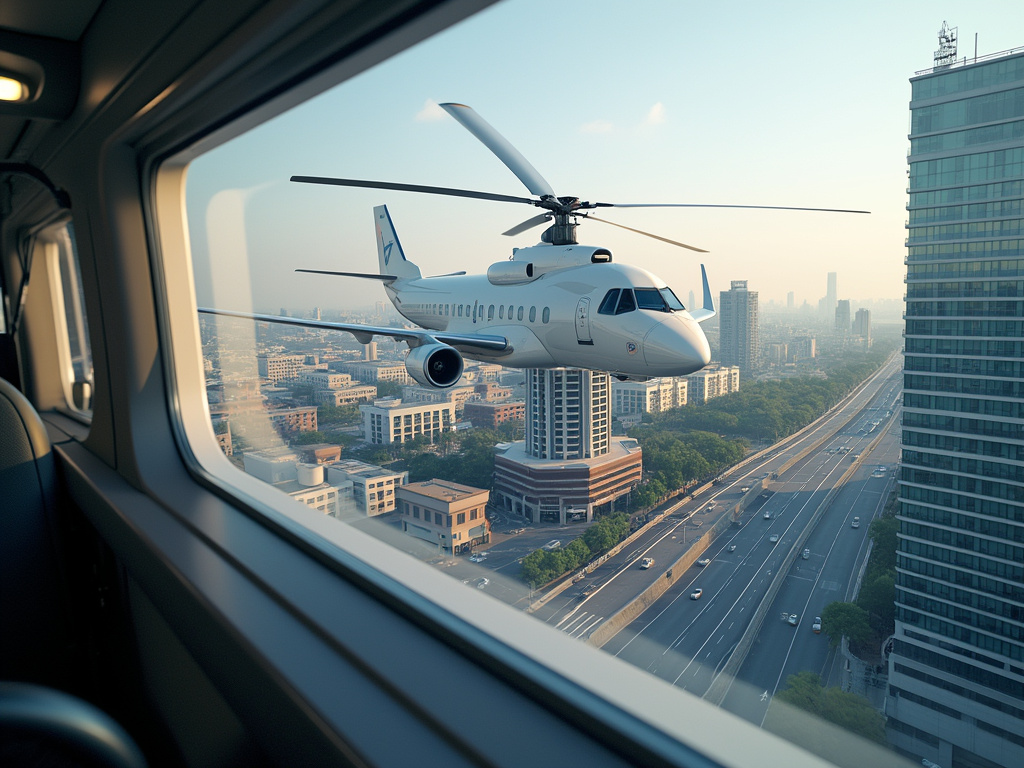Urban Air Mobility (UAM) is transforming city transportation with the advent of electric vertical take-off and landing (eVTOL) aircraft. These flying taxis promise to revolutionize short-distance travel, offering swift, eco-friendly alternatives to ground transportation in congested urban areas.
Key Takeaways:
- eVTOL aircraft are set to provide zero-emission, low-noise urban transportation
- Companies like Joby Aviation and Volocopter are spearheading UAM development
- Vertiports on building roofs will serve as key infrastructure for flying taxis
- Flying taxis could reduce travel time from Manhattan to JFK Airport to just seven minutes
- Regulatory bodies are working towards certification and integration of UAM into existing airspace
The Future of Urban Transportation: eVTOLs and Vertiports
Urban Air Mobility is poised to change the way we move within cities. At its core, UAM involves using electric vertical take-off and landing aircraft for low-altitude flights in urban environments. Key players in this emerging field include Joby Aviation, Volocopter, and Archer Aviation, each pushing the boundaries of what's possible in urban air transport.
The infrastructure to support this new mode of transportation is already in development. Plans are underway to create vertiports on building rooftops, with New York City even considering the conversion of an existing Manhattan heliport to accommodate flying taxis. Airports are also getting on board, with Joby and Delta collaborating with the Port Authority of New York to integrate UAM services at JFK and LaGuardia airports.
Revolutionary Technology and Environmental Benefits
The technology behind flying taxis is as impressive as their potential impact. Zero-emissions electric motors, co-developed by industry leaders Honeywell and DENSO, power these eVTOL jets. Advanced fly-by-wire systems and cloud-connected avionics like Honeywell Anthem ensure safe and efficient operations.
The environmental benefits of UAM are significant. During flight, these aircraft produce no CO2, nitric oxide, or other harmful pollutants. Noise pollution, a common concern with air travel, is also addressed. Joby's aircraft, for instance, registers at just 45.2 A-weighted decibels (dBA) at 1640 feet altitude, while Volocopter's VoloCity becomes inaudible at 120 meters.
However, challenges remain, particularly in battery management and route optimization. Developers are working to enhance battery life and create algorithms for efficient flight paths to maximize the potential of this technology.
Operational Capabilities and Market Potential
The operational capabilities of flying taxis are impressive. Joby's eVTOL boasts a 100-mile range on a single charge, capable of covering 99% of trips within New York City. This translates to cutting travel time from Manhattan to JFK Airport from over an hour by car to just seven minutes by air.
Most eVTOLs are designed to carry 4-6 passengers, optimized for quick, back-to-back flights. The market potential extends beyond New York, with cities like Atlanta, Los Angeles, San Francisco, and regions in South Florida and Texas identified as prime candidates for UAM services.
To prepare for this future, California has passed legislation to ready itself for commercial UAM operations. Researchers are also developing algorithms for optimal routing and scheduling, using real-world taxi data from cities like Washington, D.C. to refine their models.
Regulatory Landscape and Commercial Launch
The regulatory landscape for UAM is rapidly evolving. Volocopter's VoloCity is on track to become the first internationally certified eVTOL, with EASA certification expected soon. Meanwhile, Joby and Archer Aviation are aiming to launch passenger-carrying flights by 2025, pending FAA approval.
Strategic partnerships are accelerating development and integration. Joby's collaboration with Delta Air Lines and Volocopter's various industry partnerships are prime examples of how the UAM sector is preparing for widespread adoption.
In California, an advisory panel has been established to address UAM development, infrastructure needs, and equity issues. This proactive approach demonstrates the growing recognition of UAM's potential to reshape urban transportation.
As we stand on the brink of this transportation revolution, it's clear that flying taxis are no longer a distant dream but a near-future reality. With continued technological advancements and regulatory support, Urban Air Mobility is set to take off, promising faster, cleaner, and more efficient travel in our increasingly congested cities.
Sources:
Smart Cities Dive
TechXplore
Honeywell
Urban Air Mobility News
Volocopter






